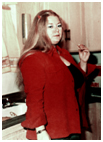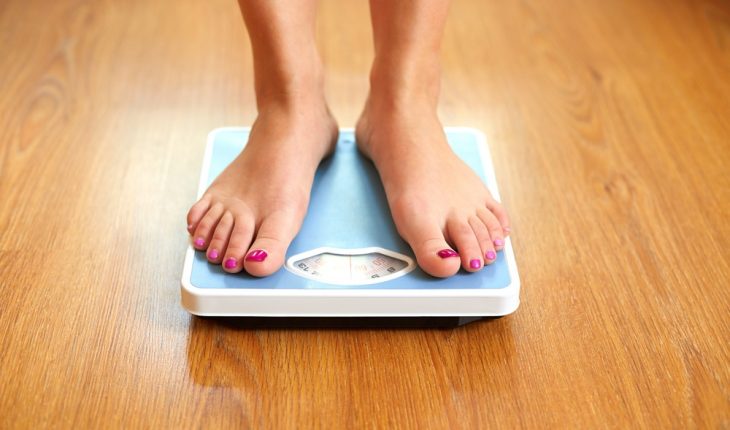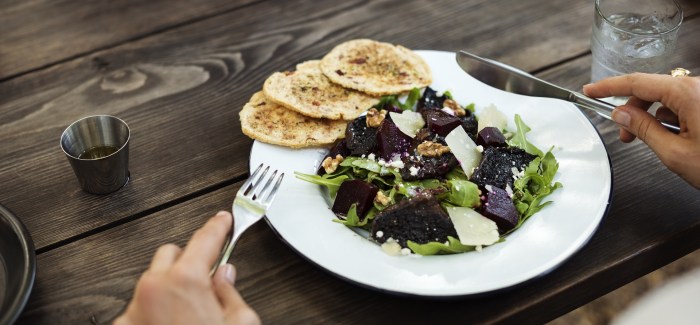
This is me at 220 pounds. The incident about to be described happened 2-3 weeks before this picture was taken.
It is 1976 and I’m 27 years old, lying on a big red beanbag chair in my living room in an apartment in Santa Monica, California. I was wrapped up in a red-and-white blanket, and I had the flu. I mean the 104-degree temperature, ready-to-vomit kind of flu, when I turned to my now ex-husband and told him to go to Mina’s Pizzeria and get me a Mina’s Special. Hmmm, let me see if I can remember — mushrooms, black olive, green pepper, sausage, meatball and pepperoni — everything (but anchovy) pizza.
Ordering and eating pizza when about to throw up can be categorized as pathological, but maybe it isn’t. An incident that explains this weird behavior occurred in East Meadow, Long Island, New York. The year was 1949.
I was about three months old and sleeping in my crib. Dad said the event happened at approximately1:00 in the morning. All of a sudden my temperature got really, really high. It resulted in me having a minor convulsion and blacking out. The doc later told my mom how when infants black out as a result of a fever, which is typically the body’s natural way to bring down the fever. The problem in this case was that the moment before blacking out, I had vomited.
Luckily for me, whenever I was put in my crib Skipper (our wire-haired fox terrier) would place himself beneath the bed where I slept, keeping constant vigilance over me. If I was in the crib, Skip was underneath. There was one time a guest came in trying to see the new baby and Skipper attacked them. From that point on, no strangers were allowed into my room if not accompanied by a family member. Skipper had to be told “It’s okay, Skip, they won’t hurt the baby. The dog would then allow the visitors to get close to the crib.
Getting back to the infamous incident—the vomit had clogged my breathing passages. I was told how Skipper, upon hearing my distress, began barking at the top of his lungs and running back and forth from my parents to my room. Dad came running in and turned the light on. I had already stopped breathing and was turning blue. He screamed for Mom to call the fire department while he picked me up from my feet hitting me on the back. My airways cleared, and I began crying. As poor as we were, every year after the incident my Dad donated $25.00 to the fire department because they had arrived in less than five minutes to administer oxygen to me. To this day, when very fatigued I have a tendency to mix up d’s and b’s when writing, and I use wrong words changing the context for some of my thoughts, but other than that, I don’t think there is any residual brain damage. If so, it appears to be quite minimal J.
From then on, whenever I had a fever as a child the whole household was in an uproar. I’d be lifted out of a sound sleep and thrown into a bathtub filled with as many ice cubes as they could muster. Thermometers weren’t even relied upon as that would take too long. All that was needed was a warm forehead. Being yanked out of bed at all hours of the night and thrown into the tub containing ice-cold water were common occurrences in our household. Fast forward……
I was about eight years old, in bed, and getting over a fever when I had to go to the bathroom. Since everyone was sleeping and the household quiet, I knew it was very late. Walking out of my bedroom there was Mom sleeping on the floor outside my door. I was very careful not to wake her. The following morning I was upstairs in Mom’s bed watching TV. She was cooking on the stove and it smelled good. I yelled down “Mom, that smells good. Can I have some?” Whereby she yelled back, “Thank God, you’re hungry: it means you’re getting better.”
Back to 1976. Eating Mina’s Pizza meant I wasn’t going to die. Bottom line, having a fever was terrifying for me. At 220 pounds on a 5-foot-2-inch frame, you don’t argue with coping strategies, especially when they are rooted in a pre-verbal time in your life.
Granted, though a dramatic example, my intent is to describe how current food events are often merely the result of learning. Early family experiences provide the foundation for how habits arise from getting consistent and frequent behaviors that are paired to events. While many early paired associations are fine and dandy, some eating behaviors are counterproductive to having a healthy and happy life and often cause us to feel bad and out of control.
Since the turn of the 19th Century, there have been many attempts to fix the problem of non-hunger eating. Drugs, research regarding controlling hunger by severing hunger centers in the brains of rats, gastric by-pass surgery, LAP-BANDs, and abiding by caloric ceilings are examples. It is evident that the medical model remains the protocol for virtually every treatment for controlling food choices. That model views overeating as a disease that has to be cured.
Whenever I had a fever, profound feelings of terror would surface whereby eating was the assurance I was on the road to recovery. Recollections from my past prevented me from considering there were any options for my survival until September, 1980 when I met Dr. Irwin Lublin. He had begun researching a weight-loss method in 1963 that would eventually become the Immaculate Consumption Program.
With his guidance, I began to research options for taking care of myself in many ways besides self-soothing with food. If we see that our food choices are the result of learned habits, we simply need to re-learn some new ones more consistent with our goals. Assuming the role of a scientist, you will learn in my program how to objectively, dispassionately, and methodically take note of and archive your own current behaviors as an objective and logical experimenter.
By applying the methods taught to me in 1980, I was able to make my own experiences involving my food choices highly visible. So much so that today, whenever I get sick with a fever, I get into bed, drink lots and lots of fluids to perspire, pull the covers over my head and stay put until my fever breaks. The “eating to prove I wasn’t going to die habit” while dramatic, is the one of the reasons that for over three decades I’ve been committed to helping others “de-pathologize” those times when they find themselves eating for reasons other than hunger.
My recently published book, Immaculate Consumption: The Road to Lifelong Weight Management hopefully, will accomplish that as the goal. I’ve provided the information: it’s now all up to you, kiddo!
- Fearless Fabulous You - May 13, 2018
- THE ERIC HOFFER AWARD FOR BOOKS - May 3, 2018
- Sheila Glazov: Your Brain’s ‘Color’/Deena Solomon: Weight Loss - May 2, 2018




Leave A Comment
You must be logged in to post a comment.